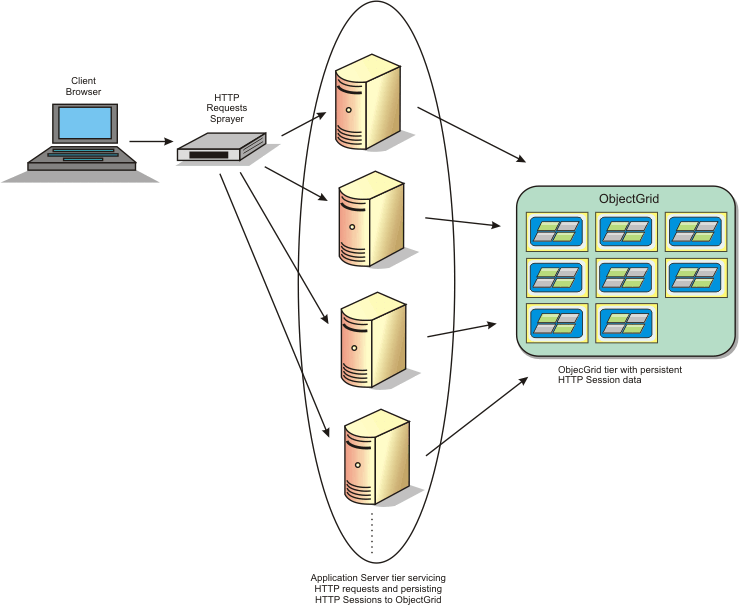HTTP session management
![]() The session replication manager that is shipped with WebSphere® eXtreme Scale can work with the default session manager in WebSphere Application Server. Session data is replicated from one process to another
process to support user session data high availability.
The session replication manager that is shipped with WebSphere® eXtreme Scale can work with the default session manager in WebSphere Application Server. Session data is replicated from one process to another
process to support user session data high availability.
Features
The session manager has been designed so that it can run in any Java™ Platform, Enterprise Edition Version 6 or later container. Because the session manager does not have any dependencies on WebSphere APIs, it can support various versions of WebSphere Application Server, as well as vendor application server environments.
The HTTP session manager provides session replication capabilities for an associated application. The session replication manager works with the session manager for the web container. Together, the session manager and web container create HTTP sessions and manage the life cycles of HTTP sessions that are associated with the application. These life cycle management activities include: the invalidation of sessions based on a timeout or an explicit servlet or JavaServer Pages (JSP) call and the invocation of session listeners that are associated with the session or the web application. The session manager persists its sessions in a fully replicated, clustered and partitioned data grid. The use of the WebSphere eXtreme Scale session manager enables the session manager to provide HTTP session failover support when application servers are shut down or end unexpectedly. The session manager can also work in environments that do not support affinity, when affinity is not enforced by a load balancer tier that sprays requests to the application server tier.
Usage scenarios
The session manager can be used in the following scenarios:- In environments that use application servers at different versions of WebSphere Application Server, such as in a migration scenario.
- In deployments that use application servers from different vendors. For example, an application that is being developed on open source application servers and that is hosted on WebSphere Application Server. Another example is an application that is being promoted from staging to production. Seamless migration of these application server versions is possible while all HTTP sessions are live and being serviced.
- In environments that require the user to persist sessions with higher quality of service (QoS) levels. Session availability is better guaranteed during server failover than default WebSphere Application Server QoS levels.
- In an environment where session affinity cannot be guaranteed, or environments in which affinity is maintained by a vendor load balancer. With a vendor load balancer, the affinity mechanism must be customized to that load balancer.
- In any environment to offload the processing required for session management and storage to an external Java process.
- In multiple cells to enable session failover between cells.
- In multiple data centers or multiple zones.
How the session manager works
The session replication manager uses a session listener to listen on the changes of session data. The session replication manager persists the session data into an ObjectGrid instance either locally or remotely. You can add the session listener and servlet filter to every web module in your application with tooling that ships with WebSphere eXtreme Scale. You can also manually add these listeners and filters to the web deployment descriptor of your application.
This session replication manager works with each vendor web container session manager to replicate session data across Java virtual machines. When the original server dies, users can retrieve session data from other servers.

Deployment topologies
The session manager can be configured using two different dynamic deployment scenarios:- Embedded, network attached eXtreme Scale container servers
- In this scenario, the eXtreme Scale servers are collocated in the same processes as the servlets. The session manager can communicate directly to the local ObjectGrid instance, avoiding costly network delays. This scenario is preferable when running with affinity and performance is critical.
- Remote, network attached eXtreme Scale container servers
- In this scenario, the eXtreme Scale servers run in external processes from the process in which the servlets run. The session manager communicates with a remote eXtreme Scale server grid. This scenario is preferable when the web container tier does not have the memory to store the session data. The session data is offloaded to a separate tier, which results in lower memory usage on the web container tier. Higher latency occurs because the data is in a remote location.
Generic embedded container startup
eXtreme Scale automatically starts an embedded ObjectGrid container inside any application-server process when the web container initializes the session listener or servlet filter, if the objectGridType property is set to EMBEDDED. See Servlet context initialization parameters for details.
You are not required to package an ObjectGrid.xml file and objectGridDeployment.xml file into your web application WAR or EAR file. The default ObjectGrid.xml and objectGridDeployment.xml files are packaged in the product JAR file. Dynamic maps are created for various web application contexts by default. Static eXtreme Scale maps continue to be supported.
This approach for starting embedded ObjectGrid containers applies to any type of application server. The approaches involving a WebSphere Application Server component or WebSphere Application Server Community Edition GBean are deprecated.